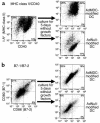Antigen-pulsed dendritic cells expressing macrophage-derived chemokine elicit Th2 responses and promote specific humoral immunity
- PMID: 11560961
- PMCID: PMC200925
- DOI: 10.1172/JCI11564
Antigen-pulsed dendritic cells expressing macrophage-derived chemokine elicit Th2 responses and promote specific humoral immunity
Abstract
Macrophage-derived chemokine (MDC) is a potent chemoattractant for antigen-specific T lymphocytes. We hypothesized that Adenovirus- (Ad-) transduced dendritic cells (DCs) overexpressing MDC would enhance the T cell-mediated humoral immune response specific for antigens presented by the DC. We challenged two strains of mice with lethal Pseudomonas aeruginosa infection 3 weeks after immunization with AdMDC-modified DCs pulsed with heat-killed P. aeruginosa. MDC-expressing DCs specifically attracted T lymphocytes and preserved typical DC surface phenotypes without growth factors in vitro. Mice immunized with AdMDC/Pseudomonas/DCs developed high levels of serum anti-Pseudomonas Ab's and were protected from a lethal respiratory challenge with Pseudomonas. The in vivo protective immunity required CD4(+) T cells, B cells, and IL-4, but not CD8(+) T cells and IL-12. AdMDC/DCs pulsed with Pseudomonas yielded significant but not absolute cross-protection against different strains of P. aeruginosa. Pseudomonas-pulsed AdMDC/DCs protected mice from Pseudomonas but not Escherichia coli and vice versa; this microbe-specific protection correlated with microbe-specific induction of CD4(+) T cell proliferation and IL-4 secretion. Based on these observations, AdMDC-modified DCs pulsed with a killed bacteria may be a useful approach to vaccination against infectious disorders.
Figures










References
-
- Banchereau J, Steinman RM. Dendritic cells and the control of immunity. Nature. 1998;392:245–252. - PubMed
-
- Banchereau J, et al. Immunobiology of dendritic cells. Annu Rev Immunol. 2000;18:767–811. - PubMed
-
- Constant SL, Bottomly K. Induction of Th1 and Th2 CD4+ T cell responses: the alternative approaches. Annu Rev Immunol. 1997;15:297–322. - PubMed
-
- Chang M, et al. Molecular cloning and functional characterization of a novel CC chemokine, stimulated T cell chemotactic protein (STCP-1) that specifically acts on activated T lymphocytes. J Biol Chem. 1997;272:25229–25237. - PubMed
Publication types
MeSH terms
Substances
Grants and funding
LinkOut - more resources
Full Text Sources
Other Literature Sources
Molecular Biology Databases
Research Materials

